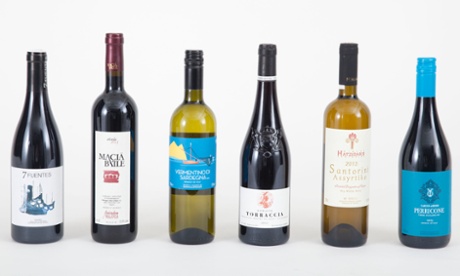
Until a couple of years ago, I knew little about the wines of the Canary Islands. I was aware they had vines in this archipelago just off Africa. I had a dim memory, from school Shakespeare lessons, that Elizabethans had once been fond of them (according to The Oxford Companion to Wine, a “cup of canary” is mentioned by a character in Twelfth Night). And I’d heard anecdotes from family and friends returning from Tenerife or Lanzarote about the quality of the local plonk.
I wasn’t – and still wouldn’t be – alone in my ignorance. As the Spanish wine industry’s promotional website freely admits even now, Canary Island wines are an unknown quantity. But since tasting the remarkable wines made by Suertes del Marques in Tenerife, I’ve been trying to get my hands on as many as possible. Made from vines planted on steep volcanic slopes, the Suertes wines are utterly distinctive. The reds have a spicy, peppery character to go with vivid red, floral-edged fruit; the white has a tongue-coating richness of texture, herbs and minerals. All the wines have an untamed acidity, lightness of alcohol and freshness that is just what sommeliers are looking for at the moment. (And which is why I’m far from the only wine lover who’s been raving about them.)
I owe my discovery of Suertes and the Canaries to the specialist importer Indigo Wine. And it was while tasting another of Indigo’s portfolio from a place which, from a wine point of view, is scarcely less obscure – the reds made by the 4 Kilos winery on Mallorca – that a penny dropped. Why is it, I wondered, that an increasing number of my favourites are made on islands?
It’s not just a Spanish thing. If I were to take a cruise around my favourite vinous islands, I might start with the 10 official appellations of the Canary Islands, before heading to Madeira, with its incomparably nervy, everlasting, fortified wines. Then to Sardinia and Corsica, with their different minglings of French and Italian winemaking traditions and grape varieties, and to Sicily’s ethereal red and mineral white renaissance. Then there’s the lemon-scented assyrtiko in Santorini, the herbal dafni and plyto of Crete, and the sumptuous spiced berries of plavac mali reds on Croatia’s Hvar. I might even include a detour to Tasmania where growers have carved out a cool-climate oasis for chardonnay and pinot noir.
It’s a disparate and by no means exhaustive bunch, defined as much by their differences as the qualities they have in common. If you were looking for a theme, you could say they all benefit to an extent from the moderating influence of a maritime climate, but then so too do vineyards in coastal parts of mainland Europe – and there’s a world of difference between the sub-tropical warmth of Madeira and the dry hot summers of Crete.
What they do all share – and this is why I reckon so many of the UK’s more interesting suppliers are listing more island wines – are winemaking cultures that are a knight’s move away from those on their respective mainlands. Idiosyncracies and quirks – as well as unusual indigenous grape varieties and winemaking practices – thrive in areas that have never felt at the centre of things, despite, in most cases, having wine cultures dating back millennia. And while none of these small winemaking scenes have the scale to be the next big thing, the wines they make are, as the guys at Indigo say of Suertes del Marques, rarely less than intriguing.
Six of the best island wines
Suertes del Marques Fuentes Listán Negro
Orotaro Valley, Tenerife, Spain 2012 (£10.95, The Wine Society)
There’s distinctive character to spare in Suertes de Marques’ entry-point red, the old listán negro vines grown on volcanic slopes drawing out a wine that is reminiscent of northern Rhône syrah in its mix of fragrant red and black fruit, pepper and wiry tannin, but with a distinctive earth-and-mineral character all its own.
Macià Batle Tinto Añada
Mallorca, Spain (£10.95 Rannoch Scott, Slurp.co.uk)
Tasting this blind, you might place it in Catalonia, you may think of France’s Languedoc, but its blend of the local manto negro with a clutch of Bordeaux and Rhône varieties is a wonderful winter-warming red with plenty of gutsy tannin to add texture to the ripe cherry-brambly fruit, and a winning note of wild flowers.
Marks & Spencer Vermentino di Sardegna,
Sardinia, Italy 2013 (M&S, £7.50)
In terms of both the grape varieties used and their style, Sardinian wines, red and white, stand somewhere between the south of France and Tuscany. Using a variety common to both those regions, vermentino, this is a classic dry Mediterranean white, lemon-fresh with pears, a hint of thyme and salt.
Domaine de Torraccia Porto Vecchio Rouge Vin de Corse
Corsica, 2011 (£13.95, Yapp Bros)
Like Sardinia, Corsica offers a mix of Italianate and southern French influences, the blend here a mix of local nielluccio and sciacarello with the Rhône’s syrah and grenache to make a chewy red of cherry and blackberry with Mediterranean evening scents of warm earth and woody herb.
Hatzidakis Assyrtiko Santorini
Greece 2013 (£11.99, Waitrose)
The local assyrtiko vine is at home on the Greek volcanic island of Santorini, and never better than in the hands of the great Haridimos Hatzidakis, who here brings the tang and tingle of lemon pith, zest and juice, smoky minerals, and juicy acidity in a scintillating dry white for herby white fish.
Caruso & Minini Perricone
Sicily, Italy 2012 (£7.99, Marks & Spencer)
Over the past two decades, the dynamism and creativity of Sicily’s winemakers has put many on the mainland to shame. From one of its less heralded local varieties, perricone, this offers a massive hit of fresh dark cherry and oregano cut with dark chocolate bitterness.

